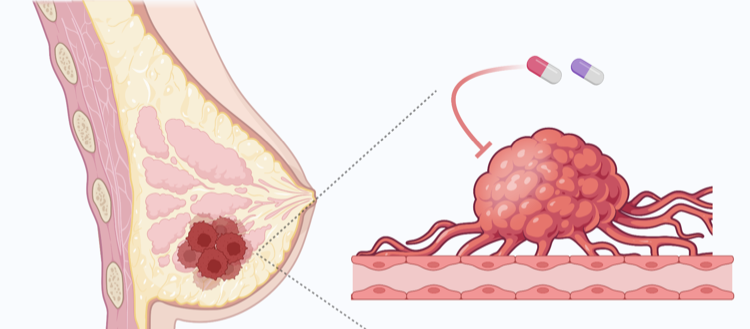
Many breast cancer patients develop resistance to standard drug treatments aimed at preventing the growth of cancer cells. A team from the University of Geneva (UNIGE) has identified a molecular regulator involved in these resistance mechanisms, informs UNIGE in this press release. The loss of this regulator leads to the proliferation of cancer cells – even if they are treated – through a signaling pathway that can itself be inhibited by another treatment. The team’s findings make it possible to consider dual therapy for certain patients whose tumors no longer respond to standard treatment. This work can be read in the journal Cancers.
In the majority of patients with breast cancer, one of the female hormones – estrogen – plays a harmful role. In about two-thirds of breast cancers, the tumors contain a receptor for this hormone, which is produced by the ovaries. When estrogen binds to its receptor, it stimulates the growth of cancer cells. To treat these forms of tumors sensitive to hormones, it is possible to use hormone therapy, which consists of a drug treatment to prevent the cancer cells’ stimulation by the female hormone.
More than a third of patients become resistant to treatment
The standard molecule used in the treatment of hormone-sensitive breast cancer is tamoxifen. This molecule, which binds to estrogen receptors to block them, prevents estrogen binding and thus the stimulation of cancer cell growth. However, in about 40% of treated patients, the cancer cells eventually develop resistance to this molecule.
The laboratory of Professor Didier Picard of the Department of Molecular and Cellular Biology of the Faculty of Science of the UNIGE is interested in the molecular mechanisms responsible for these resistance phenomena. The biologists used a genetic approach on cancer cell lines to look for factors that promote the development of tamoxifen resistance. “We used the CRISPR/Cas9 molecular scissors technique to generate cells in which a different gene was removed each time. We then observed the cancer cells able to proliferate even in the presence of tamoxifen,” explains Vasiliki Vafeiadou, a master’s student in the Department of Molecular and Cellular Biology and first author of the study. Thus, the scientists identified that low levels of the SPRED2 protein cause cancer cells to become resistant to treatment.
Combining drugs for better treatment
When present in sufficient quantities, this protein prevents cell growth by blocking a signaling pathway that activates cell proliferation. When it is absent – or present in low amounts – then cell growth is activated, even in the presence of tamoxifen, which prevents estrogen-dependent stimulation. “By analyzing databases listing the expression levels of certain genes in patients, we were able to see that those with low levels of SPRED2 have a poorer prognosis,” says Dina Hany, a researcher in the Department of Molecular and Cellular Biology and co-lead author of the study.
A treatment capable of inhibiting this estrogen-independent cell activation pathway is already in clinical trials. The authors therefore propose to combine tamoxifen with this other molecule in patients with low levels of SPRED2. “There are obviously still many studies to be conducted, but this combination of treatments could be very promising,” concludes Didier Picard.
Also interesting: An elusive microorganism provides key to replacing injections with tablets
Selected for you!
Innovation Origins is the European platform for innovation news. In addition to the many reports from our own editors in 15 European countries, we select the most important press releases from reliable sources. This way you can stay up to date on what is happening in the world of innovation. Are you or do you know an organization that should not be missing from our list of selected sources? Then report to our editorial team.







